Don M. Winn's Blog
February 28, 2024
There’s a Duck in the House

I’m so excited to announce the March 5th release of my new picture book There’s a Duck in the House! This book is based off an event that happened to me and my wife last year (although there may be a few imaginative additions to the story), when a duck came down our chimney and appeared in the living room at our house. It was a little harder to get it back outside than we expected!
The StoryFrank and Martha Tuttle were enjoying a lazy morning when they heard a terrible noise inside their house. What could it be? A wild duck had fallen down the chimney! Frank and Martha try and try to help the duck back outside, but the duck wants to stay.
He likes their house. He likes their bathtub. He likes their closets and their clothes and their snacks and their chairs and their names and most of all he likes Frank. Frank does not agree. What do you do when a duck won’t leave?
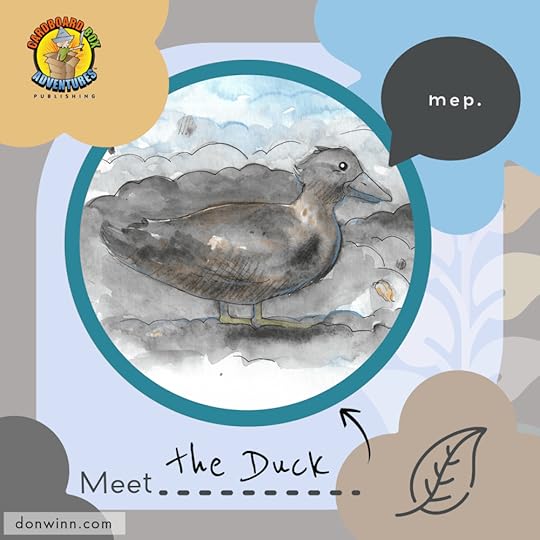
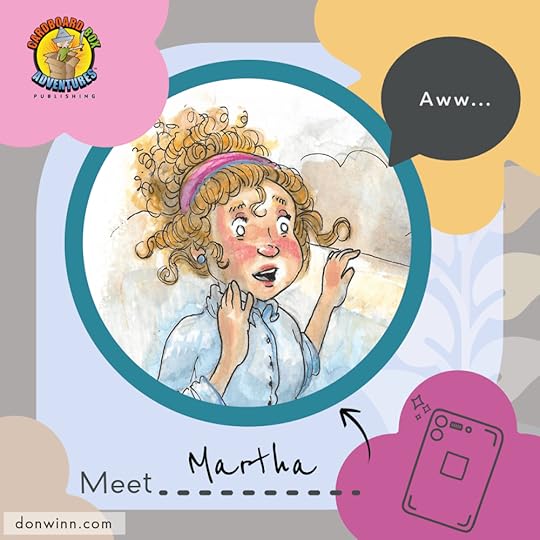
 The Illustrator
The IllustratorI am thrilled that the talented Joshua Wichterich was able to lend his talents to the realization of this story. Joshua was so patient and accommodating in helping me find just the right look for “the duck” and in fine-tuning each illustration to fit my vision of this story. And he absolutely got the right look for Frank and Martha on the very first try. Thanks, Joshua!
If you’d like to learn more about Joshua as an artist or his artist’s process, see my blog interview with Joshua Wichterich.
 Details
DetailsThere’s a Duck in the House comes in two sizes. The softcover is 5.5 in. by 8.5 in. (the same size as the Sir Kaye softcover books). The hardcover is larger, at 8.5 in. by 11 in. and is great for shared reading. The book is 22 pages long and contains approximately 1800 words. It is available from various online retailers, including Amazon, Barnes & Noble, Amazon.ca, Amazon.co.uk, Amazon.com.au, and others.
The e-book is currently only available from Amazon. I’m also planning an audiobook version and a Spanish language version in the future. Keep an eye out for future newsletters for more information.
ISBN: 978-1-937615-63-5 (Softcover)
ISBN: 978-1-937615-65-9 or ASIN: B0CT9189YG (e-book)
ISBN: 978-1-937615-66-6 (Large Format Hardcover)
 Reviews
ReviewsHere are some early reviews of the book:
“Five-Star Review! A wonderfully illustrated, highly amusing story 6- to 8-year-olds will love. Highly recommended!” —The Wishing Shelf
“A riotously funny adventure . . . Told in simple language so young readers can easily follow along, the plot follows the duck’s invasion of Frank and Martha’s house and the messy havoc that follows his every step. The illustrations add to the humor of the unfolding plot and readers young and old will be sharing more than a few chuckles. This is a great story for quality, shared family time. Loved it!” — Emily-Jane Hills Orford for Readers’ Favorite Book Reviews
“Your child will ‘quack up’ at the antics of this duck. The book is enjoyable to read, and the illustrations delight the eyes.” —Philip Van Heusen for Readers’ Favorite Book Reviews
“An unusual and funny story that I enjoyed reading. The adventures of Frank, Martha, and the duck made me laugh so much, and I am sure all young readers will be thrilled and want to read this story over and over again. Don M. Winn describes the characters and their moods very well (Frank’s desperation is hilarious), and thanks to the beautiful images, readers will love the heroes even more; the duck, in particular, is just adorable. There is a need for stories that make young readers laugh, and this is the perfect book to entertain them. I recommend There’s a Duck in the House to anyone who wants to read an amusing and original story to their children. They will certainly be entranced by it.” —Astrid Iustulin for Readers’ Favorite Book Reviews
“This enchanting book is not just a visual treat. It is an engaging shared reading experience for children of all ages.” —Mimie Odigwe for Readers’ Favorite Book Reviews
“I was in hysterics, laughing so hard my stomach hurt. Don M. Winn’s hilarious tale, based on a true story, amused me so much that I contacted my mother, who lives on the other side of the world, and told her what I’d just read. For the first time, a single book connected us both emotionally via a long-distance phone call. The illustrations are perfectly in sync with the story and I have a feeling that There’s A Duck In The House will be one of those wonderful tales that is handed down through generations, causing many giggles for years to come. Amazing stories such as this type are what keep a party flowing, adding a hefty dose of mirth to the festivities. I believe adults and children alike will love There’s A Duck In The House.” — Rosie Malezer for Readers’ Favorite Book Reviews
 The original duck
The original duckCardboard Box Adventures picture books are great for shared reading and can help parents establish a strong preliteracy foundation for their children. Check out the CBA Catalog for a full list of award-winning picture books, chapter books, and resources for parents and educators. Visit my Amazon author page for more information.
The post There’s a Duck in the House appeared first on Author Don Winn Blog.
January 4, 2024
Illustrator Joshua Wichterich
I’d like to introduce you to a new (well, new to me) award-winning artist and illustrator, Joshua Wichterich (also known as Joshua B. Wichterich).
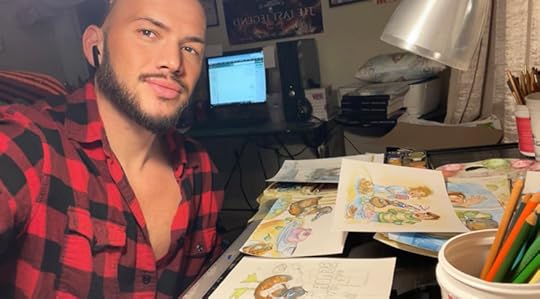
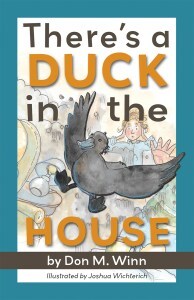
I will soon be releasing a new illustrated book for young readers called There’s a Duck in the House. This book was inspired by an actual event that happened to me early in 2023. But more about that in a bit. I’ve been working with Joshua over the last several weeks as he illustrates the new book, and I couldn’t be more excited about the quality of his work. His vision is a perfect fit for the story.
Normally when I interview someone, I always ask about how they got their start and a little bit about their background, but since Joshua already has that information on his website (see below), I wanted to focus more on his process for illustrating a story, specifically centered around the work he is doing on There’s a Duck in the House. So without any further ado, here is Joshua Wichterich.
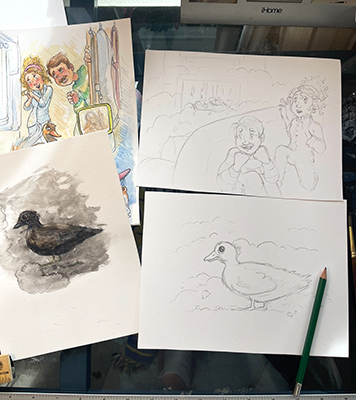
Don: Joshua, thank you so much for sharing your process with my readers. When illustrating a book, how do you determine the best way to illustrate each scene?
Joshua: You’re welcome! Thank you so much for choosing me to be a part of this great book!
I’m a visual person. Ever since I was a kid my head was always in the clouds. God gave me a gift of imagination, so usually while I read a book manuscript, images and a visual storyline will come to me. For a children’s book of over 600 words, I’ll usually use a main point to illustrate, which is always something with action or the most interesting scene. After coming up with the layout and character concepts of the illustrations, everything just flows.
Don: The illustrations for There’s a Duck in the House are fantastic. Can you share with us your process of illustrating a book?
Joshua: Thank you! I am proud to say that I am a traditional illustrator, but with that comes a more tedious process. I will come up with a rough sketch first, then fine-tune it as a line drawing. I will then show the author, and once it is approved, I will start painting it. Then I will ink it. After inking it I will quickly clean it up and get rid of the sketch marks with an eraser, and then go in with a little color with a color pencil. Then I will scan it and upload it into a program where I will further clean it up and finalize it digitally. Then off to the author it goes to be approved once more.

Don: One aspect of your illustrations that I especially love is how well the facial expressions of the characters help tell the story. How did you develop this skill?
Joshua: Thank you and I appreciate you noticing them! My most favorite thing to do in illustrating is bringing the characters to life with relatable expressions and quirks. I always found it boring when looking at kid’s cartoons and books where the characters all looked the same with the same poker face on. Everyone is unique and deserves a humanistic face full of expression.
Thank you again, Joshua for sharing your work with us. To learn more about illustrator Joshua Wichterich and his work, visit his website at: https://www.thelastlegendawakened.com/

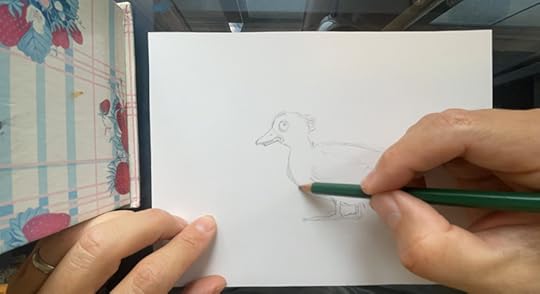 The Inspiration Behind There’s a Duck in the House:
The Inspiration Behind There’s a Duck in the House:
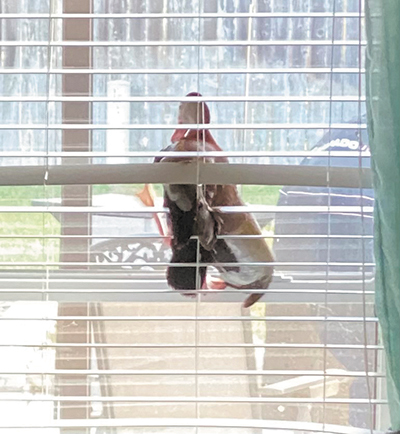
One predawn morning in the summer of 2023, I had just gotten out of the shower when I heard a terrible noise. My wife went to investigate, and when she entered the living room, she saw a shadow in the dark room that looked like a giant vulture. Panicked, she yelled, “There’s something in the house!”
When I got to the living room and turned on the light, to my surprise, I found that a terrified young wood duck had somehow fallen down the chimney and, with his wings wildly flapping, he was trying to get back out again through the nearby window. While my wife opened the front door and tried to get the duck out of the house, I had to get my camera to document this most unusual event. After a short episode of duck wrangling, my wife got the duck safely out of the house.
Thanks for reading about illustrator Joshua Wichterich and his work and my new book There’s a Duck in the House!
Cardboard Box Adventures picture books are great for shared reading and can help parents establish a strong preliteracy foundation for their children. Check out the CBA Catalog for a full list of award-winning picture books, chapter books, and resources for parents and educators. Visit my Amazon author page for more information.
The post Illustrator Joshua Wichterich appeared first on Author Don Winn Blog.
May 23, 2023
Eating Together, Being Together
Recently, I came across a special book written by a husband and wife about the value of preparing and eating family meals together. The wife, Dr. Caroline Clauss-Ehlers, PhD, is a psychologist, and the husband, Julian Clauss-Ehlers, is a classically trained, New York Times-starred chef. Entitled Eating Together, Being Together: Recipes, Activities, and Advice from a Chef Dad and a Psychologist Mom, the book makes the argument that family meals offer a wealth of benefits, and not just from a nutritional standpoint.
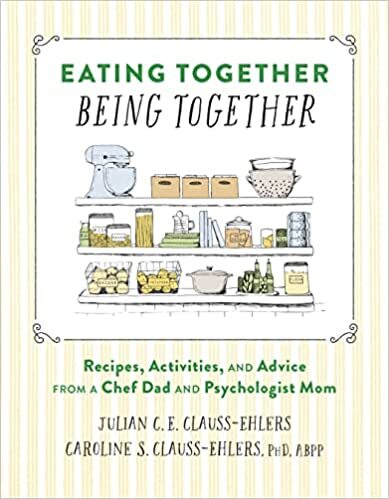
This couple observes that “magical things happen for people around food: Kids open up while they measure flour and mix batter; adults tell stories of their childhood while they eat a favorite family recipe; bad feelings are mitigated; memories are made.”
Before the pandemic, this couple and their three children were like so many other families: busy, with each family member on their own schedules. Mom ate dinner with the youngest son at 5 p.m., and he was in bed by seven o’clock; his sisters would join their mom at 7:30 for their meal, while dad came home at 10 p.m. and ate alone.
But when they experienced quarantine during the pandemic, they started eating together as a family every night. Suddenly (and for the first time) they were eating together all the time. They write, “this experience left us with a greater awareness of the value and benefits of family mealtime.”
Additionally, this book contains an abundance of information about how to have honest food discussions with family members. Julian, the father, was classically trained in France, where the food culture encourages eating mindfully and savoring the flavors of each dish, a philosophy he tries to pass down to his children.

They write, “Share with your child the reason why he can’t just eat chicken nuggets his entire life. And guess what? In doing this, you and your child are having a conversation. You’re thinking through decisions, considering outcomes, and perhaps most important, listening to one another.”

Unlike some books that encourage stealth vegetables, a.k.a. hiding zucchini or carrots in the chocolate cake and banana bread, this book takes a more honest, holistic, transparent approach. They write, “To make these good choices, kids need to be aware of what they’re eating instead of being fooled into consuming a healthy option without knowing it. Developing self-awareness about food choices and involving children in food preparation early on equip kids to be thoughtful eaters who make healthy choices.”
These activities also offer great opportunities to bond together and have meaningful dialog. Who of us hasn’t experienced asking our child how their day went, and receiving either radio silence or a few mumbled, monosyllabic responses? However, during shopping, meal prep, and family meals, everyone gets to talk about their day and share thoughts and feelings in a relaxed atmosphere.
The book presents a lovely blend of parenting tips and insights from the mom and recipes and cooking tips from the dad. It’s also chock-full of activity opportunities, broken down by age groups. It’s a unique and well-rounded (and very encouraging) guide for parents looking to establish healthy eating habits and strong family bonds through mealtime. Highly recommended!
Cardboard Box Adventures picture books are great for shared reading and can help parents establish a strong preliteracy foundation for their children. Check out the CBA Catalog for a full list of award-winning picture books, chapter books, and resources for parents and educators. Visit my Amazon author page for more information.
The post Eating Together, Being Together appeared first on Author Don Winn's Blog.
April 18, 2023
Dyslexia Inspiration Intervention
Dyslexia Inspiration Intervention
You can listen to this blog.People with dyslexia often have to work harder than others to accomplish necessary tasks in school and in adult life. Dyslexia is not a simple reading problem. It is a disorder that affects how information is processed. There is no cure for dyslexia, so it is essential that people with dyslexia develop grit and tenacity in order to stick with necessary tasks and continue to create positive outcomes despite the many challenges they face. Inspiration plays a large role in the development of grit and tenacity in people with dyslexia. Maybe a young dyslexic learner that you know could use a little dyslexia inspiration intervention. What are some ways to help dyslexic learners find the inspiration that speaks to them?
Perhaps it sounds unoriginal, but one way to help a person to find their inspiration is through the use of inspirational quotes. They have been found to boost brain functioning and feelings of well-being. Using inspirational music, quotes, or stories can also give a boost to a person’s motivation, confidence, perseverance, and resilience.

In an article titled “From Languishing Dyslexia to Thriving Dyslexia: Developing a New Conceptual Approach to Working with People with Dyslexia,” Chathurika S. Kannagara describes how some dyslexic learners implemented specific strategies that positively changed their lives. Many of these strategies involves shifts in perspective about their situation. These shifts in perspective allowed the dyslexic learners to embrace hope, self-acceptance, and often ambition. Finding the right kind of inspiration can jump-start a positive shift in perspective for a dyslexic learner.
Quotes—that is, words—are not the only sources of inspiration. The use of inspirational music in schools is also a way for students to channel their emotions in a positive way. Studies have shown that listening to motivational music can reduce anxiety and improve mood. Music has been used effectively in hospitals to calm patients and help them cope with pain and other medical situations and procedures. It can be a comforting and powerful way to help students connect with their emotions and develop a more positive outlook on life.
Tobias Bashevkin of the University of Bergen studied the effects of different types of music on listeners. He stated that “while previous research has supported music as a strong modulator of emotion, our study uncovered that music also influences the content of thoughts. We found thoughts to be more positive, active, motivated, and constructive when listening to heroic music.”

Dyslexic learners can be very hard on themselves if they choose to focus on negative aspects of their differences. Imagine the benefits to young dyslexic students if their thoughts could regularly be refreshed in the direction of feeling more “positive, active, motivated, and constructive”!
With lifelong issues like dyslexia, ADD/ADHD, and ASD, inspirational interventions can help children and teens develop the coping skills they need to face life’s challenges with a positive attitude. Never underestimate the power of inspiration as a way for non-neurotypical people to uplevel their life.
The music and/or inspirational quotes that will speak to your child all depends on your child. We are all different. Be observant of your child’s struggles as well as their strengths and help them find the music and/or inspirational words that speak to them. You may be surprised at the results.
(Side note: A dyslexia inspiration intervention is a term I made up to convey the idea of helping often-discouraged dyslexic learners find a little extra encouragement and motivation to keep going through the use of either inspirational quotes or music. As far as I know, it’s not a formal form of intervention.)
As an example, an inspirational poem that spoke to me when I was a young man is by Edmund Vance Cooke. To me, it resonated with empowering ideas about the grit and tenacity that many of us dyslexics have no choice but to develop. It gave me the courage to choose to keep going, no matter what life and my brain threw at me.
Please don’t be put off by its references to death; it’s really a poem about living and our daily opportunities to make choices. Remember that every person is different; this poem may not provide inspiration for your child or student, but I promise you there is something out there that will both touch their hearts and inspire them.
How Did You Die?
Edmund Vance Cooke (1866–1932)
Did you tackle that trouble that came your way
With a resolute heart and cheerful?
Or hide your face from the light of day
With a craven soul and fearful?
Oh, a trouble’s a ton, or a trouble’s an ounce,
Or a trouble is what you make it,
And it isn’t the fact that you’re hurt that counts,
But only how did you take it?
You are beaten to earth? Well, well, what’s that?
Come up with a smiling face.
It’s nothing against you to fall down flat,
But to lie there—that’s disgrace.
The harder you’re thrown, why the higher you bounce;
Be proud of your blackened eye!
It isn’t the fact that you’re licked that counts,
It’s how did you fight—and why?
And though you be done to the death, what then?
If you battled the best you could,
If you played your part in the world of men,
Why, the Critic will call it good.
Death comes with a crawl, or comes with a pounce,
And whether he’s slow or spry,
It isn’t the fact that you’re dead that counts,
But only how did you die?
Thank you for reading this article about ideas for a dyslexia inspiration intervention. For a thorough discussion of dyslexia, you may enjoy the second edition of my award-winning book Raising a Child with Dyslexia: What Every Parent Needs to Know, available in softcover, hardcover, eBook, and audio. In addition to facts on testing and accommodation, my book gives you the tools to provide the social and emotional support children with dyslexia require.
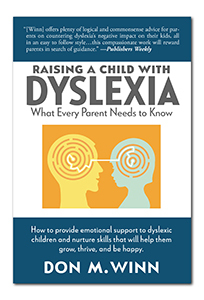
And to learn more about how every student best learns to read, you may also enjoy Failing Students or Failing Schools? A Parent’s Guide to Reading Instruction and Intervention, by reading specialist and shortlisted World Literacy Award nominee Faith Borkowsky.
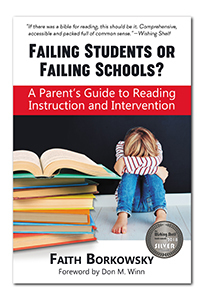
Cardboard Box Adventures picture books are great for shared reading and can help parents establish a strong preliteracy foundation for their children. Check out the CBA Catalog for a full list of award-winning picture books, chapter books, and resources for parents and educators. Visit my Amazon author page for more information.
Further Information:
The Role of the Visual Arts in Enhancing the Learning Process (https://www.ncbi.nlm.nih.gov/pmc/articles/PMC3274761/)Study finds heroic music stimulates empowering and motivating thoughts (https://www.psypost.org/2019/08/study-finds-heroic-music-stimulates-empowering-and-motivating-thoughts-54308)Positive Emotions and Academic Achievement (https://wp.nyu.edu/steinhardt-appsych_opus/positive-emotions-and-academic-achievement/)The Connection Between Mental Health and Academic Success (https://www.groveslearning.org/connection-between-mental-health-academic-success/)The Power of Music to Reduce Stress (https://psychcentral.com/stress/the-power-of-music-to-reduce-stress)Broderick, Patricia C., and Stacie Metz. “Learning to BREATHE: A Pilot Trial of a Mindfulness Curriculum for Adolescents.” Advances in School Mental Health Promotion 2, no. 1 (22 December 2001): 35-46. https://doi.org/10.1080/1754730X.2009.9715696Kannagara, Chathurika S. “From Languishing Dyslexia to Thriving Dyslexia: Developing a New Conceptual Approach to Working with People with Dyslexia.” Frontiers in Psychology, no. 6 (24 December 2015): https://doi.org/10.3389/fpsyg.2015.01976The post Dyslexia Inspiration Intervention appeared first on Author Don Winn's Blog.
March 24, 2023
Auditory Dyslexia
Auditory dyslexia is a neurological difference that makes understanding the separate sounds of language less automatic. This condition is sometimes also called auditory processing disorder. While most children are born with a brain that is ready to begin understanding the sounds and patterns of speech naturally and intuitively, not all kids have automatic wiring for this key part of learning.
How common is auditory processing disorder?Both children and adults can have auditory dyslexia. It’s estimated that between 3 and 20 percent of the population struggles with some level of auditory dyslexia. This is especially important to know because when school-age children have a hearing difficulty that shows up as a sensory processing challenge, it can affect their ability to learn. Only about 5 percent of school-aged children dealing with auditory dyslexia actually get diagnosed and accommodated.
Research shows that up to 70 percent of people who have dyslexia also have some degree of dyslexia-related auditory processing difficulties. That means that many dyslexic children also have auditory dyslexia, although they and their parents may be unaware that they have it. Only a small number of children are ever diagnosed and treated for auditory processing disorders. Many of these kids may live with undetected challenges affecting their learning until adulthood and then discover they have literacy problems that were never fully addressed in childhood. They can hear words just fine, but their brain has trouble interpreting sound meaningfully.
Auditory processing disorder may also be associated with autism. Children with autism may have difficulty understanding and using spoken language. An auditory processing disorder can be present in addition to other disabilities that interfere with a child’s ability to communicate effectively with others and learn new information.
What is auditory dyslexia?Here’s what you need to know about auditory dyslexia.
Hearing plays an essential role in the development of spoken language in children. Children with auditory dyslexia (aka auditory processing disorder) may be able to hear perfectly well, but they have difficulty understanding and processing what is being said.
A child with auditory processing disorder may cover their ears, avoid loud noises, have difficulty following directions, or be unable to understand what is being said by teachers or other adults. They may also perform poorly in school or have difficulty making friends because they find it difficult to understand other people’s speech and cues in social situations.

Adults with auditory dyslexia often have trouble understanding conversations or following directions, especially if there is more than one speaker or a lot of background noise. They may find it difficult to focus on, remember, or understand new information.
How do auditory processing disorders affect learning and literacy?Phonemic awareness is the ability to see and manipulate individual sounds, such as hearing the difference between b and d or between p and q. It’s an essential ability for the development of language skills. Most people develop phonemic awareness naturally as children, although it may take longer for some kids. By age three, most children have developed the ability to understand the basic structure of speech and can distinguish between similar-sounding words such as cat and bat.
However, people with auditory dyslexia often lack phonemic awareness and may not recognize the individual sounds that make up a whole word. They often mispronounce words or have trouble sounding out letters or syllables. They may have difficulty recognizing rhyming words or blending sounds together to form words and sentences. They may not be able to distinguish the subtle differences in the sounds that make up a word. This can affect their ability to learn to read with accuracy and fluency.
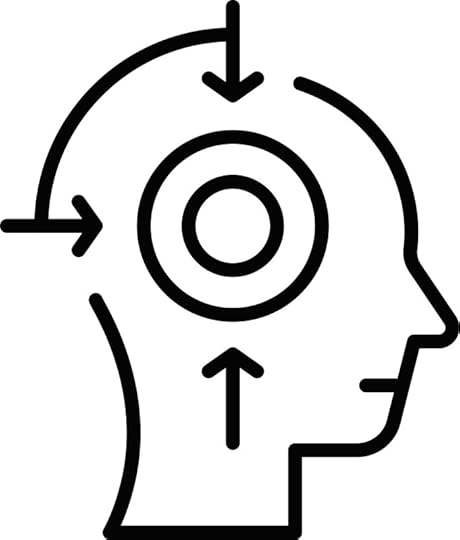 What if I suspect my child has auditory dyslexia?
What if I suspect my child has auditory dyslexia?Early detection and treatment of auditory dyslexia in children is important. Research shows that early intervention can minimize developmental delays and improve reading achievement. Early intervention also can reduce the likelihood that children with auditory processing problems will experience learning and social setbacks later in life. That’s why it’s important to have a comprehensive hearing assessment to identify children with auditory processing issues as early as possible. Early intervention and treatment can help children with auditory processing disorders develop strong language skills, improve reading comprehension, and improve social skills.
Speech-language pathologists and audiologists can help identify children with auditory dyslexia and provide individualized intervention and treatment to improve their communication skills. If your child has an auditory processing disorder, it’s essential that they receive appropriate treatment and intervention.
One form of intervention they may recommend is phonics instruction. Phonics instruction is a system of learning to read by associating letters with sounds. It uses an artificial system (like phonics rules) to teach children how to recognize written symbols representing spoken words. The idea is that once children can associate the sounds represented by letters with the sounds made by spoken English words, they can then use those sounds to decode written words. All students benefit from learning phonemic awareness through phonics instruction. For those struggling to understand the spoken word, extra time spent on this aspect of education can make all the difference in their educational success and experience.
For a thorough discussion of dyslexia, you may enjoy the second edition of my award-winning book Raising a Child with Dyslexia: What Every Parent Needs to Know, available in softcover, hardcover, eBook, and audio. In addition to facts on testing and accommodation, my book gives you the tools to provide the social and emotional support children with dyslexia require.

And to learn more about how every student best learns to read, you may also enjoy Failing Students or Failing Schools? A Parent’s Guide to Reading Instruction and Intervention, by reading specialist and shortlisted World Literacy Award nominee Faith Borkowsky.

Cardboard Box Adventures picture books are great for shared reading and can help parents establish a strong preliteracy foundation for their children. Check out the CBA Catalog for a full list of award-winning picture books, chapter books, and resources for parents and educators. Visit my Amazon author page for more information.
References:
I can hear, just not clearly. Do I have hearing loss? (https://www.healthyhearing.com/report/32039-I-can-hear-just)What is dyslexia? (https://www.readingrockets.org/article/dyslexia-basics)Developmental Problems (https://courses.lumenlearning.com/suny-hccc-ss-152-1/chapter/developmental-problems/)Effects of Hearing Loss on Development AUDIOLOGY (https://www.asha.org/siteassets/ais/ais-hearing-loss-development-effects.pdf)Hearing Loss and Its Effects on Speech and Language Development (https://health.choc.org/hearing-loss-effects-speech-language-development/)6-Year-Old Child Development Milestones (https://www.verywellfamily.com/6-year-old-developmental-milestones-620703)Sensory Processing in Autism: A Review of Neurophysiologic Findings (https://www.ncbi.nlm.nih.gov/pmc/articles/PMC3086654/)Does My Child Have Autism? (https://www.helpguide.org/articles/autism-learning-disabilities/does-my-child-have-autism.htm)Most common cause of early Reading Writing and Spelling Disabilities (https://www.ldrfa.org/causes-early-signs-of-writing-and-reading-disabilities/)Understanding Dyscalculia and Dyslexia: What’s the Relationship (https://www.lynnekenney.com/post/understanding-dyscalculia-and-dyslexia-what-s-the-relationship-1)How to Teach Kids With Dyslexia to Read (https://childmind.org/article/how-to-teach-kids-with-dyslexia-to-read/)The post Auditory Dyslexia appeared first on Author Don Winn's Blog.
March 5, 2023
Understanding Dysgraphia
Understanding dysgraphia. Dysgraphia is a sibling condition to dyslexia that affects a person’s ability to hold a pencil properly, perform the movements necessary to write legibly, and get their thoughts down on paper. When someone has dysgraphia, they may experience writing as a difficult or even painful task.
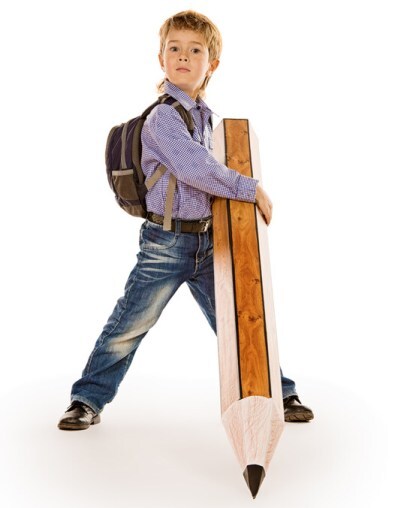
Dysgraphia is sometimes called dysorthographia or developmental coordination disorder. Occasionally, it is inaccurately referred to as dyspraxia. While dyspraxia can affect a child’s ability to write, it also involves other physical challenges and is a separate entity in its own right. (See Understanding Dyspraxia.)
Some people believe that learning to write is important for developing critical thinking skills and effective communication, so having difficulties with writing can be incredibly frustrating. However, a treatment program can help people with dysgraphia learn to overcome these challenges and become more effective writers.
Dysgraphia is a 2011 documentary film (Dysgraphia – Documentary) about dysgraphia. In the film, dysgraphia is described as a physical inability to form letters, resulting in a number of problems such as decreased reading comprehension, trouble expressing ideas, poor handwriting, and the inability to express emotions in writing. The film highlights the struggles of seven students as they learn to cope with their disabilities and try to improve their writing skills.
As a person with dysgraphia, my only cursive writing is my signature, and it is very chaotic and barely legible. When I am forced to write on paper rather than type on my computer, I write everything in block capital letters and do so very slowly and laboriously. This is not at all uncommon for folks with dysgraphia.
It can also be a real challenge for me to get my thoughts and ideas down on paper (or the computer screen). It has always felt as if there’s a sort of disconnect between my ideas and making them concrete.
I’m in good company; mystery writer Agatha Christie had such severe dysgraphia that she dictated all of her stories to a secretary. Winston Churchill had dysgraphia and had great difficulty composing his speeches and writing them down in longhand. Albert Einstein also had dysgraphia and used note cards to help him write down his thoughts.
According to a 2011 article in Slate magazine, dyslexia expert Nancy Mather estimates that “up to one in twenty people suffer some degree of dysgraphia.” The article quotes another researcher as saying that many people with this condition can go their entire lives without ever realizing they have it. The author of this article suggests that dysgraphia may be more common than we think.
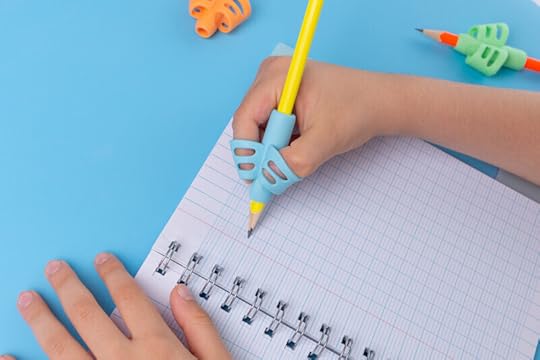
Although having and understanding dysgraphia is often a lifelong challenge, it is manageable with the proper support and treatment. If your child is diagnosed with dysgraphia, several things can help:
Pencil grip appliances are widely available online and help many kids learn to write.Some kids find it easier to learn to write on special paper, such as graph paper or paper with slightly raised lines.Some children benefit from having others around to help them. Some schools have aides who help kids with dysgraphia, especially in classes where writing is required.Children with dysgraphia also sometimes benefit from using a stylus or touch-typing on a computer instead of writing by hand.The dyslexia and dyspraxia friendly Touch-Type Read and Spell Program teaches touch-typing in a unique way, so that writing can be linked to muscle memory and become more automatic.If your child has dysgraphia, it’s important to remind them often that even though it’s labor-intensive to write, what they have to say is important and it’s well worth their extra time and hard work to keep on writing.
Thank you for reading about Understanding Dysgraphia. For a thorough discussion of dyslexia, you may enjoy the second edition of my award-winning book Raising a Child with Dyslexia: What Every Parent Needs to Know, available in softcover, hardcover, eBook, and audio. In addition to facts on testing and accommodation, my book gives you the tools to provide the social and emotional support children with dyslexia require.

And to learn more about how every student best learns to read, you may also enjoy Failing Students or Failing Schools? A Parent’s Guide to Reading Instruction and Intervention, by reading specialist and shortlisted World Literacy Award nominee Faith Borkowsky.

Cardboard Box Adventures picture books are great for shared reading and can help parents establish a strong preliteracy foundation for their children. Check out the CBA Catalog for a full list of award-winning picture books, chapter books, and resources for parents and educators. Visit my Amazon author page for more information.
Further Information:
Classroom accommodations for developmental coordination disorder (https://www.understood.org/en/articles/at-a-glance-classroom-accommodations-for-dcd)The upside to dyslexia, even as a journalist (https://www.cnn.com/2019/06/06/health/dyslexia-benefit-curnow)How to help a child with dyspraxia (https://www.readandspell.com/us/how-to-help-a-child-with-dyspraxia-in-the-classroom#:~:text=A%20child%20with%20dyspraxia%20may,movements%20required%20for%20physical%20education%2C)The post Understanding Dysgraphia appeared first on Author Don Winn's Blog.
February 6, 2023
Effects of Dyscalculia
What is dyscalculia? What are the causes and effects of dyscalculia? It is a sibling condition to dyslexia. It affects a person’s ability to do math, work with numbers, and perform tasks that require doing things in sequential steps.
Dyscalculia is also known as “math dyslexia” or “number dyslexia.” It is estimated to affect between 5 and 7 percent of the population, with higher rates among children with ADHD and autism. A common misconception is that dyscalculia is just a milder form of dyslexia. However, the two conditions are different and have different causes.
Dyscalculia is believed to have genetic origins and is comorbid with dyslexia in about 50 percent of cases. It can also be caused by brain injury, stroke, or other neurological disorders. There is no cure for dyscalculia. Treatment focuses on improving math skills through visual training and cognitive remediation.
There are two types of dyscalculia: acquired dyscalculia and developmental dyscalculia. Acquired dyscalculia occurs later in life. It is caused by damage through accident or injury to the areas of the brain that control math skills. Developmental dyscalculia shows up during childhood. It usually runs in families but can also occur randomly.
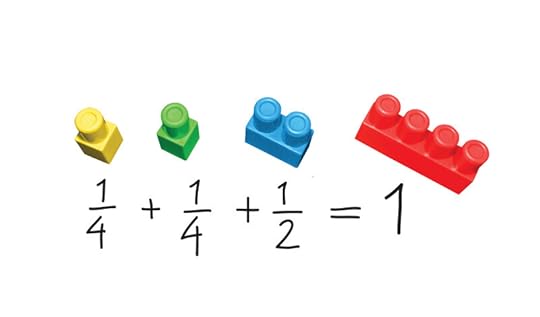
Individuals who have always struggled with math may have developmental dyslexia. Symptoms may include difficulty performing basic arithmetic operations such as addition, subtraction, multiplication, and division. They may also include problems understanding fractions, decimals, percentages, money, and place value. Adults with this condition often have difficulty balancing a checkbook, keeping track of monthly bills, or calculating sales tax or a tip at a restaurant.
In addition to math-based learning challenges, another one of the effects of dyscalculia can include poor spatial awareness. This can make it difficult for people with dyscalculia to perform everyday tasks like measuring food or cooking meals.
Dyscalculia also impacts a person’s ability to find their way while driving. Remembering which turns to make in which direction and in what order can be extremely difficult. In my own case, I get lost easily, struggle to navigate, and will usually turn the wrong way (literally every time) unless someone tells me otherwise or I have the GPS going to follow its prompts.

Often, a young child’s first manifestations of dyscalculia can be trouble learning to tie shoes because tying shoes involves performing a sequence of actions, and it can be hard to remember which steps to do in what order. Another early symptom of dyscalculia can be difficulty following through on things that they’ve been asked to do when more than one item is on the list. In my childhood, I could usually remember the first item on the list, but I lost track of the other things on the list after that.
Therein lies one of the most psychologically impactful effects of dyscalculia—the child is often accused of being inattentive, lazy, or not caring enough about what they’re being asked to do. Nothing could be farther from the truth!
When a child starts school and is asked to do something with numbers, the teacher will often offer to “help” the child by saying things like, “Just tell me how many steps there are,” or, “Just tell me which number comes after three.” This can be confusing for children with dyscalculia because they rely so heavily on physical counting in order to make sense of the world around them. When they are asked to recall a sequence of steps/numbers without the use of a physical counter, this causes tremendous anxiety for them. It can also cause them to feel as if they are the only ones who are having problems with a certain subject.
Dyscalculia is a neurological difference, which means that it is not technically a learning disability, but a learning disorder. Dyscalculia can be diagnosed by testing a child’s ability to acquire mathematics and to retain and recall number sequences. There are other, more subtle clues that can point to the possibility of dyscalculia. For example, some children have difficulty processing visual information quickly and may have difficulty interpreting visual symbols such as graphs and charts. Other children have trouble recalling number sequences, even when it is written out for them on a piece of paper.
A dyscalculia diagnosis involves analyzing mathematical performance by using standardized testing and clinical examination. In addition to these diagnostic procedures, children with dyscalculia are usually evaluated by a team of professionals who assess their cognitive skills and determine their overall level of functioning.

Thank you for reading about the effects of dyscalculia. For a thorough discussion of dyslexia, you may enjoy the second edition of my award-winning book Raising a Child with Dyslexia: What Every Parent Needs to Know, available in softcover, hardcover, eBook, and audio. In addition to facts on testing and accommodation, my book gives you the tools to provide the social and emotional support children with dyslexia require.

And to learn more about how every student best learns to read, you may also enjoy Failing Students or Failing Schools? A Parent’s Guide to Reading Instruction and Intervention, by reading specialist and shortlisted World Literacy Award nominee Faith Borkowsky.
Cardboard Box Adventures picture books are great for shared reading and can help parents establish a strong preliteracy foundation for their children. Check out the CBA Catalog for a full list of award-winning picture books, chapter books, and resources for parents and educators. Visit my Amazon author page for more information.
Additional Information:
Dyscalculia (https://www.firstlightpsych.com/blog/learning/dyscalculia)Dyslexia & Dyscalculia (https://safespot.org.uk/safespotopedia/dyslexia-dyscalculia/)Understanding Dyscalculia and Dyslexia: What’s the Relationship (https://www.lynnekenney.com/post/understanding-dyscalculia-and-dyslexia-what-s-the-relationship-1)Symptoms of Dyscalculia (https://www.learningsuccesssystem.com/dyscalculia/symptoms-dyscalculia)About Dyscalculia (https://mgiep.unesco.org/article/about-dyscalculia) (https://ndpublisher.in/admin/issues/LCV7N3b.pdf)Dyscalculia Primer and Resource Guide (https://www.oecd.org/education/ceri/dyscalculiaprimerandresourceguide.htm)Dyscalculia (https://www.psychologytoday.com/us/conditions/dyscalculia)What Is Dyscalculia? (https://psychcentral.com/health/dyscalculia-symptoms)Yes, your child can be tested for Dyscalculia | List of Dyscalculia Tests (https://adayinourshoes.com/dyscalculia-test/)The post Effects of Dyscalculia appeared first on Author Don Winn's Blog.
January 18, 2023
Understanding Dyspraxia
Understanding Dyspraxia
You can listen to this blog.When I was a kid, my mom called me a bull in a china closet. For those unfamiliar with this term, it means that the person is really clumsy and accident prone and that they are unaware of how their movements can impact or endanger delicate and/or valuable objects.
I was constantly embarrassed because of bumping into things, breaking things, and spilling my milk, to name just a few of my issues. Little did any of us know that there was actually a name for my condition—dyspraxia. Now that I have a better understanding of dyspraxia and the nature and scope of this condition, I have grown to respect it rather than be embarrassed by it.
Dyspraxia is a form of developmental coordination disorder (DCD). Dyspraxia affects a person’s ability to control muscle movements. In more severe cases, it can also affect balance and coordination. It can also inhibit a child’s ability to socialize. Those who suffer from dyspraxia may find it difficult to make friends and maintain relationships due to their clumsiness and lack of coordination.
Dyslexia is a language-based reading disorder, and dyspraxia is a difficulty with motor skills. Dyslexia is more commonly recognized, but dyspraxia should not be forgotten—it’s a common learning disability that affects motor skills, coordination, and balance. Both conditions have been shown to stem from differences in brain development.

According to the Dyspraxia Foundation UK, around 4% of children have dyspraxia. In most cases, dyspraxia does not cause any major impairment or get in the way of a child’s development. However, it can make it more difficult to learn basic skills such as handwriting and fine motor skills, which can make schoolwork more challenging for children with a dyspraxia diagnosis.
The Dyspraxia Foundation UK says that while most people with dyspraxia do not have significant learning difficulties, those who have a severe form of the condition can have difficulties with learning and concentration in school. There are often delays in speech and language development which may lead to a slurred or mumbled speech pattern.
Sometimes these symptoms can continue into adulthood too. In some cases, the condition is linked to other disorders such as dyslexia.
In adults, dyspraxia can affect a person’s ability to do everyday tasks such as getting dressed, cutting food, or driving a car. It can also affect a person’s speech. Some people may experience pain or weakness in the muscles that control their hands and arms, which can make it painful to hold a pen or pencil to write.
Dyspraxia can cause problems with planning and organization skills and can lead to feelings of embarrassment. This can affect social skills and confidence. These issues can have a significant impact on a student’s ability to function at school.

Dyspraxia can affect children of any age, and symptoms usually appear before the age of four. Although the severity of symptoms can vary from child to child, there is usually a gradual onset of difficulty in these areas of functioning. The symptoms of dyspraxia also tend to persist over time and can interfere with a child’s development and learning.
A diagnosis of dyspraxia is not usually made until a child is five years old, and symptoms cannot be explained by muscle weakness or neurological conditions.
There are a number of effective treatments and strategies that can help students with dyspraxia to overcome their challenges and improve their ability to function at school. It is important for parents to be aware of the signs and symptoms of dyspraxia so that their children can receive appropriate treatment and support.
In 2016, Melissa Prunty, a pediatric psychologist, wrote “Dyspraxia: A Guide for Secondary School Teachers,” which provides guidance for secondary school teachers on how to support the learning of students affected by dyspraxia. This guide includes information on assessment strategies and classroom accommodations for pupils with dyspraxia.
Successful treatment of dyspraxia usually involves a combination of therapy and educational interventions. Speech-language therapy and occupational therapy are particularly helpful in improving the motor coordination impairments associated with this condition.
In 2012, the Dyspraxia Foundation UK and Dyspraxia Foundation Australia published “Dyspraxia: A Guide to Understanding and Supporting Children and Young People,” which aims to help parents, teachers, and health professionals understand dyspraxia and provide support for those affected by it.
If you suspect that your child may be dyspraxic, feel free to take advantage of the references linked below.
Thank you for reading the article, “Understanding Dyspraxia” For a thorough discussion of dyslexia, you may enjoy the second edition of my award-winning book Raising a Child with Dyslexia: What Every Parent Needs to Know, available in softcover, hardcover, eBook, and audio. In addition to facts on testing and accommodation, my book gives you the tools to provide the social and emotional support children with dyslexia require.

And to learn more about how every student best learns to read, you may also enjoy Failing Students or Failing Schools? A Parent’s Guide to Reading Instruction and Intervention, by reading specialist and shortlisted World Literacy Award nominee Faith Borkowsky.

Cardboard Box Adventures picture books are great for shared reading and can help parents establish a strong preliteracy foundation for their children. Check out the CBA Catalog for a full list of award-winning picture books, chapter books, and resources for parents and educators. Visit my Amazon author page for more information.
References:
What’s the difference between dyslexia and dyspraxia? (https://www.readandspell.com/us/difference-between-dyslexia-and-dyspraxia#:~:text=In%20general%2C%20a%20key%20indicator,toward%20movement%20and%20planning%20difficulties)Developmental Problems (https://courses.lumenlearning.com/suny-hccc-ss-152-1/chapter/developmental-problems/)Dyslexia, dyspraxia, and ADHD in adults: what you need to know (https://www.ncbi.nlm.nih.gov/pmc/articles/PMC4001144/)Dyspraxia (developmental co-ordination disorder) in adults (https://www.nhs.uk/conditions/developmental-coordination-disorder-dyspraxia-in-adults/)How to help a child with dyspraxia (https://www.readandspell.com/us/how-to-help-a-child-with-dyspraxia-in-the-classroom)DYSPRAXIA Secondary School Classroom Guidelines (https://dyspraxiafoundation.org.uk/wp-content/uploads/2022/07/dyspraxia-secondary-guidelines.pdf)The post Understanding Dyspraxia appeared first on Author Don Winn's Blog.
December 27, 2022
The Power of Expectation
The power of expectation on the part of parents and educators can have a strong influence on young learners, especially those who struggle with reading. How so? We will start with the story of a horse.
In 1911, a curious German psychologist named Oskar Pfungst investigated a special horse named Clever Hans. Clever Hans could perform near-miraculous feats of reading, spelling, and working math problems for his owner, math teacher Wilhelm von Osten. This horse was an international sensation; far and wide, eager readers sought news of his latest performance that indicated human-level intelligence.
So sensational were the horse’s performances—stomping out answers with his hoof—that a team of experts examined the horse and his owner and could find no sign of prompting by the owner. The horse’s responses appeared to be genuine.
Enter psychologist Oskar Pfungst. Through a series of careful experiments and observations, Fungst came to a very different conclusion, and it’s one that may be of interest to today’s educators.
Pfungst concluded, in short, that what you expect is what you get. And that humans provide subtle, unintentional clues via body language that telegraph to the other participant what their expectations are.
Let me explain. When the participants asked the horse a question, they immediately looked at Hans’ foot for the answer. And here’s the thing: every single participant had a subtle shift in their demeanor as the horse approached the correct answer. The depth of their breathing changed, or they held their breath, or their eyes shifted from focus on the hoof to the horse’s eye or raised their head slightly in anticipation of the correct answer. As Pfungst stated, there was “a high degree of tension of expectancy.”
He continued, “The state required for a successful response was not the mere passive expectation that the horse would tap the number demanded of him nor the wish that he might tap it, but rather the determination that he should do it. An inward ‘thou shalt,’ as it were, was spoken to the horse. This affective state was registered in consciousness in terms of the sensation of tension in the musculature of the head and neck, by intraorganic sensations, and finally by a steadily rising feeling of unpleasantness. When the final number was reached, the tension would suddenly be released, and a curious feeling of relaxation would ensue.”
Pfungst concluded that because horses are intelligent and observant creatures, Hans had learned to respond to the body language cues of the people asking him questions and alter his hoof responses accordingly.
The Power of Expectation in EducationTo connect the dots between Clever Hans and education, we have to look at later research done on the power of expectation in 1968 by Rosenthal and Jacobsen. Rosenthal, a Harvard professor, had done other research in 1963 that pointed to the fact that the information biases and expectations of testers in a laboratory setting impacted the results and performance of the participants in those tests. He was concerned about how much this type of influence could have on students’ potential performance in the classroom.
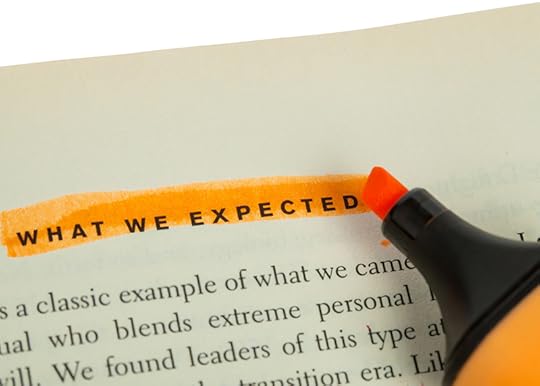
To sum up his conclusions, when teachers had an expectation (impressed upon them randomly) that a student was of higher intelligence, this expectation altered the way they related to the student in subtle ways that contributed to the fullest potential of the student. Conversely, when a child was deemed not to be gifted, this expectation also subtly altered the way the teacher responded to the student. The way teachers treated both groups of students was unintentional and unconscious.
Later research confirmed and deepened our understanding about the power of teacher expectations. Once again, researchers observed that teachers unconsciously communicate higher expectations to the students they believe have greater potential. A study conducted by Chaiken, Sigler, and Derlega (1974) consisted of videotaping teacher-student interactions in a classroom situation in which the teachers had been informed that certain children were extremely bright (these students had been chosen at random from all the students in the class).
Careful examination of the videos indicated that in many subtle ways, teachers favored the students identified as brighter.
How? They smiled at these students more often, were more patient, made more eye contact, and responded with more favorable reactions to these students’ comments in class. Researchers also noted that when educators have high expectations for students, those students are more likely to enjoy school, to receive more constructive comments from teachers on their mistakes, and to work harder to try to improve.

Such studies indicate that teacher expectancies—while not the only determinant of a child’s performance in school—can have a powerful effect on a student’s long-term potential and sense of self.
As we all work toward providing optimal learning opportunities for today’s kids, this information is a sobering reminder that what we expect is what we get. When nurturing struggling readers, it is crucial to examine ourselves for personal bias or lowered expectations and to root those out. Why? Because, as sure as Hans was a horse, our kids will pick up on those subtle differences in our expectations.
Thank you for reading about the power of expectation and education. For a thorough discussion of dyslexia, you may enjoy the second edition of my award-winning book Raising a Child with Dyslexia: What Every Parent Needs to Know, available in softcover, hardcover, eBook, and audio. In addition to facts on testing and accommodation, my book gives you the tools to provide the social and emotional support children with dyslexia require. The second edition has the same great content as the first edition but now contains a very helpful bibliography and index and an exciting new cover.

And to learn more about how every student best learns to read, you may also enjoy Failing Students or Failing Schools? A Parent’s Guide to Reading Instruction and Intervention, by reading specialist and shortlisted World Literacy Award nominee Faith Borkowsky.

Cardboard Box Adventures picture books are great for shared reading and can help parents establish a strong preliteracy foundation for their children. Check out the CBA Catalog for a full list of award-winning picture books, chapter books, and resources for parents and educators. Visit my Amazon author page for more information.
References:
https://psycnet.apa.org/record/1911-10301-000https://www.gutenberg.org/files/33936/33936-h/33936-h.htmhttps://link.springer.com/article/10.1007/BF02322211https://psycnet.apa.org/record/1974-33081-001The post The Power of Expectation appeared first on Author Don Winn's Blog.
December 6, 2022
Making Time to Read Together
Making Time to Read Together
You can listen to this blog.Reading is one of the most important activities you can do with your child. It helps them learn to read well, develops their vocabulary, and gives them a richer understanding of the world around them. But it’s also a great way to bond with your child. It’s well worth arranging your schedule (and your child’s schedule) to prioritize making time to read together.
Research shows that children who are read to every day are better readers at school, have an increased vocabulary, and enjoy language more. Parents can read to their children throughout the day, but it’s especially fun to share stories at bedtime.
Here are some suggestions for getting the most out of story time:
 Start with easy books (but choose carefully!) Try to choose books that are fun and interesting for you both but that won’t be too difficult for your child to follow or comprehend. You might also try browsing age-appropriate lists for “best-seller” books. These titles are often popular with kids and easy to find at your local library or bookstore.Making time to read together is more fun if you use your child’s interests to guide your book selection. Pay attention to what your child likes to read or do for fun. If they’re into dinosaurs, for example, you might look for books about prehistoric animals.Choose books that appeal to different learning styles. Some kids love to read about adventures and heroes, while others like stories about family and friendship. Make sure you include both types of books in your collection so there’s something to please everyone.It’s often helpful to talk about the story with your child before you read it. Let your child ask questions and talk about what they think about it. This will also help develop their critical thinking skills and help them understand what’s going on in the story.Focus on the characters and events in the story. When you read with your child, try not to get too distracted by your own life and activities. Instead, focus on the book and describe what’s happening in the story as you go. You might talk to your child about the character, where they are, what they’re doing, and why they do it. This will help you create a bridge between the story world and the real world that your child is familiar with. And they’ll be more likely to pick up language and vocabulary from the story as they listen.As you’re reading, ask your child questions about the story. “What’s that? What’s that noise? Can you say that word? What happened next? What happened before? How did you feel?” These questions help your child develop language skills and understand the story and the characters.
Start with easy books (but choose carefully!) Try to choose books that are fun and interesting for you both but that won’t be too difficult for your child to follow or comprehend. You might also try browsing age-appropriate lists for “best-seller” books. These titles are often popular with kids and easy to find at your local library or bookstore.Making time to read together is more fun if you use your child’s interests to guide your book selection. Pay attention to what your child likes to read or do for fun. If they’re into dinosaurs, for example, you might look for books about prehistoric animals.Choose books that appeal to different learning styles. Some kids love to read about adventures and heroes, while others like stories about family and friendship. Make sure you include both types of books in your collection so there’s something to please everyone.It’s often helpful to talk about the story with your child before you read it. Let your child ask questions and talk about what they think about it. This will also help develop their critical thinking skills and help them understand what’s going on in the story.Focus on the characters and events in the story. When you read with your child, try not to get too distracted by your own life and activities. Instead, focus on the book and describe what’s happening in the story as you go. You might talk to your child about the character, where they are, what they’re doing, and why they do it. This will help you create a bridge between the story world and the real world that your child is familiar with. And they’ll be more likely to pick up language and vocabulary from the story as they listen.As you’re reading, ask your child questions about the story. “What’s that? What’s that noise? Can you say that word? What happened next? What happened before? How did you feel?” These questions help your child develop language skills and understand the story and the characters.Storytime can be an important part of helping children develop a love of reading and learning from a young age. Some early education experts say that one of the best ways to help a child develop a love of reading is to read to them often. That’s why it’s important to choose books for them that will help them to develop an interest in reading and an appreciation for literature.
One great resource for parents is Scholastic’s “Top 100 Picture Books” list. This list is a great place to start if you’re looking for ideas for great books for young kids. And it can help you learn more about the kind of books and stories that your child will enjoy most.
Parents looking to learn more about how to make the most of reading time may want to check out the award-winning paid app called BabySparks (originally titled “BabySparks: 5 Steps to Help Your Baby Develop Language & Literacy Skills). It was developed by Dr. Teresa Lesiuk of McMaster University and endorsed by the Society of Developmental and Behavioral Pediatrics and the American Academy of Pediatrics. The BabySparks app provides development activities parents can do with their child that helps parents support a child’s development in areas such as gross and fine motor skills, cognition, language, sensory, etc.
Picture Books by Don M. Winn that Are Great for Making Time to Read Together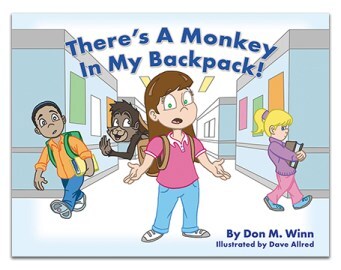
There’s a Monkey In My Backpack!
Anna has a problem! There’s a monkey who goes everywhere with her—even to school! He never leaves Anna alone. He makes so much trouble for her that she wonders if she will ever finish the third grade, but she learns that her monkey can give her some surprising help if she lets it. This book is designed for parents and educators to use to help kids understand both the difficulties and the benefits that accompany dyslexia and other learning difficulties. Watch the video here.
Space Cop Zack, Protector of the Galaxy
Space Cop Zack, GARG’s Secret Mission
Space Cop Zack, The Lost Treasure of Zandor
Zack and his robot sidekick GARG have the best, most imaginative adventures in space! Watch the video here.

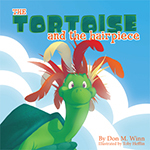
The Tortoise and the Hairpiece by Don M. Winn
A lonely little turtle is convinced that the reason he has trouble making friends is because he is bald—all the other animals have hair! He decides the way to fit in is to wear a fancy feathered wig! Does it solve his problem, or make him more of an outcast than ever before? Watch the video here.
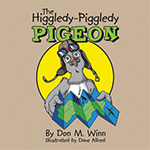
The Higgledy-Piggledy Pigeon by Don M. Winn
An ambitious young pigeon begins flight school only to discover that he has a learning challenge and can’t keep up with the other students. He’s so disappointed he’s ready to give up. Will he? Watch the video here.
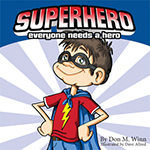
Superhero by Don M. Winn
A boy imagines he’s a superhero who solves all sorts of problems for his town, until he confronts two scary villains he’s never met before. Superhero is overwhelmed! Who does he call for help? Who is Superhero’s hero? Watch the video here.
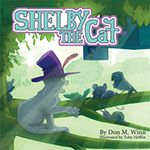
Shelby the Cat by Don M. Winn
Shelby the cat lives a peaceful life of friendship with all kinds of animals, including mice, dogs, and bugs! But a gang of mean alley cats are angry that Shelby makes them look bad, so they try to bully Shelby into being like them. Will Shelby give in or be true to himself? Watch the video here.
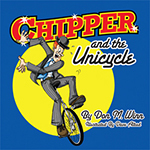
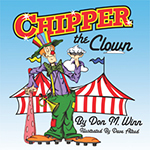
Chipper the Clown and Chipper and the Unicycle — Chipper dreams of being a clown. He makes his dream come true, but learns the importance of perseverance and asking for help. Watch the Chipper the Clown video here and watch the Chipper and the Unicycle video here.
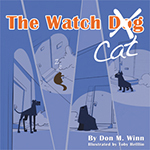
The Watch Cat — A cat bravely protects his house, even though all the neighbors laugh. Can he prove his worth? Watch the video here.
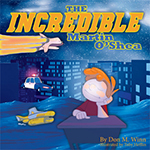
The Incredible Martin O’Shea — Martin daydreams in school! His grades are falling and his parents are worried. Will he learn to pay attention? Can he have his dreams and his education too? Watch the video here.
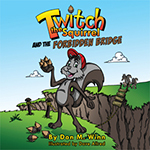
Twitch the Squirrel and the Forbidden Bridge — Twitch is not allowed to cross a dangerous old rope bridge, but there is a giant tree full of acorns on the other side. Does Twitch know better than his parents? Watch the video here.
Chapter Books by Don M. Winn that Are Great for Reading Aloud
Book 1: The Knighting of Sir Kaye — Kaye is unexpectedly knighted at twelve. Now he has to compete in a surprise tournament against the other knights. Can he win back his honor? Will he even survive? Watch the video here.
Book 2: The Lost Castle Treasure — Kaye must find a missing treasure or lose his knighthood forever. Can he beat the knight Melchor at his own game? Watch the video here.
Book 3: Legend of the Forest Beast — Kaye must stop a rogue knight from sending a mysterious shipment into Eldridge before the entire country—and his beloved father—is engulfed in war. Watch the video here.
Book 4: The Eldridge Conspiracy — Kaye must enter Eldridge to search for the only man who can save his father’s—and the king’s—life. The only problem? That man refuses to help Kaye because his family is in danger. What will Kaye do? Watch the video here.
A Friends of Sir Kaye ebook only: Mystery of the White Knight — Who is the White Knight? He ruins fields so nothing can grow, burns down entire villages, and terrifies the people of Knox. People say it’s the new queen’s fault. They want to take her throne away and give it to someone else. Can her nephew Beau save the throne for the queen and solve the mystery of the White Knight?
This is a short, easy-to-read chapter book featuring characters from the award-winning Sir Kaye the Boy Knight series in their own standalone adventures.
Thank you for reading about making time to read together. For a thorough discussion of dyslexia, you may enjoy the second edition of my award-winning book Raising a Child with Dyslexia: What Every Parent Needs to Know, available in softcover, hardcover, eBook, and audio. In addition to facts on testing and accommodation, my book gives you the tools to provide the social and emotional support children with dyslexia require.

And to learn more about how every student best learns to read, you may also enjoy Failing Students or Failing Schools? A Parent’s Guide to Reading Instruction and Intervention, by reading specialist and shortlisted World Literacy Award nominee Faith Borkowsky.

Cardboard Box Adventures picture books are great for shared reading and can help parents establish a strong preliteracy foundation for their children. Check out the CBA Catalog for a full list of award-winning picture books, chapter books, and resources for parents and educators. Visit my Amazon author page for more information.
Additional Information:
Top 10 Benefits of Reading with Your Kids https://readingwithyourkids.com/top-10-benefits-of-reading-with-your-kids/Narrative Skills: What Are They & How Do They Develop? https://babysparks.com/2019/02/20/narrative-skills-what-are-they-how-do-they-develop/The Importance of Picture Books http://resourcebinderecse.weebly.com/uploads/2/0/1/3/20133951/naeyc_importance_of_picture_books.pdfThe benefits of developing reading skills from a young age https://www.kumon.co.uk/blog/the-benefits-of-developing-reading-skills-from-a-young-age/Information about Babysparks https://babysparks.zendesk.com/hc/en-us/articles/360042433313-What-is-BabySparks-The post Making Time to Read Together appeared first on Author Don Winn's Blog.



